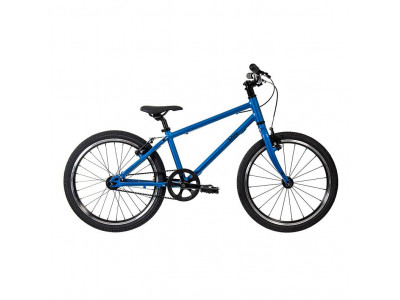Children's bikes are designed specifically for children to learn to ride and to develop their cycling skills. Not only the frame and components themselves are adapted to this, but the size of the wheels as well. It basically determines for how big of a child the bike is intended for and is the base for correct selection.
Children's bikes for the little ones usually come with help - training wheels, which are additional small wheels attached to the rear wheel of the bike. These wheels help young children learn balance and build confidence while riding a bike without the fear of falling. Children's bikes expect children to pedal to propel the bike forward. They are intended for children who have already developed a certain level of coordination and motor skills.
On the other hand, balance bikes do not have pedals. They are basically small bikes with two wheels and a frame, but no drive. Children bounce with their legs, which they use to balance and propel the bike forward.
The choice between a children's bicycle with training wheels and a balance bike depends on the age, development, and self-confidence of the child. Balance bikes are often recommended because they help children learn the most important skill needed to ride a bike: balance. They are considered a natural transition to a regular pedal bike, as children can easily transition from a balance bike to a pedal bike without the need for extra wheels.
Even with children's bicycles, modern elements such as disc brakes or single-gear sets are being promoted, which increases their safety and ease of use
What are the differences between children's and balance bikes?
The main difference between a children's bike and a balance bike lies in their construction and purpose:
- Pedals: Children's bikes are equipped with pedals, while balance bikes aren't. Children's bikes are designed to help children learn to pedal and ride initially with the help of training wheels, while balance bikes focus on helping children develop balance and coordination before transitioning to a pedal bike.
- Balance development: Balance bikes are specially designed to help children develop balance, coordination, and control at an early age. By pushing themselves with their feet and eventually sliding, children learn to balance and control the movement of the bike.
- Age range: Children's bikes are usually suitable for children aged 3 and up who have already developed some balance and coordination skills. On the other hand, balance bikes are suitable for younger children, from around 18 months to 5 years, depending on their size and development.
- Weight and size: Balance bikes are frequently lighter and smaller than children's bikes, making them easier for small children to handle and manoeuvre. They often have adjustable seat and handlebar heights to accommodate growing children.
How to choose a balance and children's bike?
There are several factors to consider when picking a children's and balance bike to ensure the best fit for your child. Here are some key factors:
Choosing a children's bike:
- Size: Make sure the bike is the right size for your child's height and leg length. The child should touch the ground with their feet while sitting on the bike, and their knees should be slightly bent when pedalling.
- Weight: Look for a light bike that is easy for a child to handle and manoeuvre. A lighter bike will be more comfortable for them to ride and control.
- Brakes: Check that the bike has brakes suitable for your child's abilities. Some children's bikes are equipped with pedal brakes (activated by pedalling backwards), others have hand brakes. Consider the child's level of coordination and comfort with each type of brake.
- Training wheels: If your child is just learning to ride, consider a bike with removable training wheels. These can give them stability and support as they develop balance and coordination.
- Adjustable components: Look for a bike with adjustable seat height and handlebar height. This allows you to adjust the bike according to how your child grows, and thus ensure comfort and proper posture while riding.
Choosing a balance bike:
- Size: Choose a balance bike that is suitable for the height and length of your child's legs. They should be able to sit comfortably on the bike with their feet flat on the ground.
- Weight: Choose a light balance bike that your child can easily lift and manoeuvre. It will be easier for them to control and learn to maintain balance.
- Adjustable components: Look for a balance bike with an adjustable seat height. This allows you to raise or lower the seat as your child grows, ensuring proper fit and comfort.
- Frame material: Frames are usually made of materials such as aluminium or steel. Consider the weight and durability of the frame material.
- Tires: Choose a balance bike with air-filled tires that absorb shocks better and ensure a smoother ride. These tires also provide better traction, making it easier for the child to maintain balance on different surfaces.
- Handlebar design: Look for a balance bike with a comfortable handlebar design that gives your child a natural grip and control over the steering. Some balance bikes have adjustable handlebars to accommodate different arm lengths.
Before choosing a balance bike, check out user reviews and tests to choose the best one for your child.

